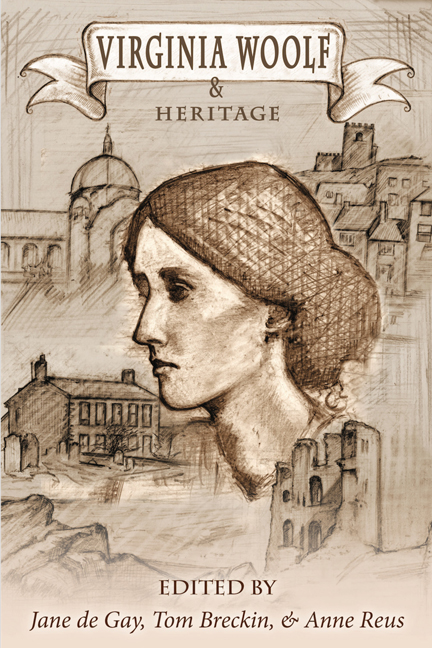Book contents
- Frontmatter
- Contents
- Introduction
- List of Abbreviations
- HERITAGE: A DEBATE
- HERITAGE, EDUCATION, AND MENTORING
- HERITAGE SPACES
- LITERARY AND CULTURAL HERITAGES
- QUEER PASTS
- MODERNISM AND HERITAGE
- WRITING LIVES AND HISTORIES
- The Play of Fact and Fiction in Virginia Stephen's “The Journal of Mistress Joan Martyn”
- “Writing the history of my own times”: Virginia Woolf and the Diary
- Heritage, Legacy, and the Life-Writing of Woolf and Rhys
- Life as Legacy: Truth, Fiction, and Fidelity of Representation in Biographical Novels Featuring Virginia Woolf
- From the Author to the Icon: A Heritage of Virginia Woolf in French Biographies and Biofictions
- Flights of Archival Imagination: Woolf 's Transcendent Materiality in Contemporary “Archive Fiction”
- WOOLF'S LEGACIES
- FINALE
- Notes on Contributors
“Writing the history of my own times”: Virginia Woolf and the Diary
from WRITING LIVES AND HISTORIES
- Frontmatter
- Contents
- Introduction
- List of Abbreviations
- HERITAGE: A DEBATE
- HERITAGE, EDUCATION, AND MENTORING
- HERITAGE SPACES
- LITERARY AND CULTURAL HERITAGES
- QUEER PASTS
- MODERNISM AND HERITAGE
- WRITING LIVES AND HISTORIES
- The Play of Fact and Fiction in Virginia Stephen's “The Journal of Mistress Joan Martyn”
- “Writing the history of my own times”: Virginia Woolf and the Diary
- Heritage, Legacy, and the Life-Writing of Woolf and Rhys
- Life as Legacy: Truth, Fiction, and Fidelity of Representation in Biographical Novels Featuring Virginia Woolf
- From the Author to the Icon: A Heritage of Virginia Woolf in French Biographies and Biofictions
- Flights of Archival Imagination: Woolf 's Transcendent Materiality in Contemporary “Archive Fiction”
- WOOLF'S LEGACIES
- FINALE
- Notes on Contributors
Summary
The first major work Virginia Woolf envisioned was a history, as was the last. Neither was written, but another, of a sort, was: her diary. Like most diaries, Woolf 's is a manifold thing. But among its many purposes and facets is the intention, explicit and sustained, to create a detailed record of the past for the future. As a diarist Woolf becomes at once archivist, historiographer, and her own posterity— both actual, in her periodic rereading of her record, and projected, in the form of “Old Virginia,” the future self she imagines sitting down to write her memoirs. The practice of diary keeping constituted an ongoing crucible for Woolf 's thinking about history: about what is preserved and what is lost, and about the work of historiography that interprets and fashions the past for the present. In creating a record of her days, Woolf becomes intimately familiar with the ideological, idiosyncratic, and aleatory nature of the historical record and, further, with the unpredictable value of its contents, as their significance shifts under the continually altering lights of time.
Around a year and a half into the sustained diary that begins in mid-1917, Woolf asks herself, “What sort of diary should I like mine to be?” Her delightful response, frequently quoted, begins:
I should like it to resemble some deep old desk, or capacious hold-all, in which one flings a mass of odds & ends, without looking them through. I should like to come back, after a year or two, & find that the collection had sorted itself & refined itself & coalesced, as such deposits so mysteriously do, into a mould, transparent enough to reflect the light of our life, & yet steady, tranquil, composed with the aloofness of a work of art. (D1 266)
This vision of the ideal diary is composed of two distinct parts. First, the diary appears as a kind of material archive, a repository for the miscellany of daily life. Second, the “deposits” thus stashed out of sight undergo a sea change: returned to in time they are found recast, unified, saturated with meaning. Curiously, the first part of the vision—vividly articulated, but a common enough modus operandi for diaries—appears in the subjunctive (“I should like”), while the second part, the radiant transformation, is presented as an inevitability (“as such deposits mysteriously do”).
- Type
- Chapter
- Information
- Virginia Woolf and Heritage , pp. 196 - 201Publisher: Liverpool University PressPrint publication year: 2017



